Gay (Homosexual) – What is it? What does it mean?
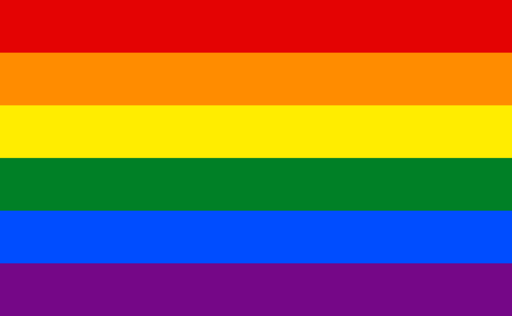 The rainbow flag
The rainbow flag
What is it?
The word gay references homosexuality or same-sex attraction. It is the sexual orientation of people who experience sexual interest towards the same gender.
As an adjective or noun, the word gay would be most commonly associated with a homosexual man, but the label can actually be used by anyone regardless of gender.
What does it mean?
Homosexuality, as opposed to heterosexuality, describes romantic and/or sexual relationships between people of the same gender.
Being gay means being attracted to people of the same sex rather than the opposite sex. This attraction can be of a sexual, emotional, physical, and/or amorous nature.
Table of Content
Other Terms
Gay lesbian – A woman who is sexually attracted to other women. Someone whose gender identity is female and whose sexual orientation is homosexual.
Queer – An umbrella term used to reference everyone who doesn’t identify as heterosexual. Someone who doesn’t (exclusively) feel attracted towards the opposite gender.
Bisexual – Someone who feels attracted to both the female and male genders.
Homophobia – Prejudice against gay people.
History
Before evolving to the meaning that is familiar to us today, the term gay was used, from the 12th until the 19th century, as a synonym for happy, cheery, untroubled.
Her face was sad and lovely with bright things in it, bright eyes and a bright passionate mouth, but there was an excitement in her voice that men who had cared for her found difficult to forget: a singing compulsion, a whispered “Listen,” a promise that she had done gay, exciting things just a while since and that there were gay, exciting things hovering in the next hour.
— The Great Gatsby by F. Scott Fitzgerald, 1925 (excerpt from Chapter I)
In the 17th century, the term became associated with promiscuity and immoral behaviors, such as prostitution and, by extension, homosexuality.
The definition of the term changed around the late 19th century, but homosexuality only became the primary description in the 1960s. It started as a common adjective for men to describe their sexual orientation, but currently, gay is used by the entire LGBTQ+ community regardless of gender.
Likewise, the Merriam-Webster Dictionary defines the word in two ways:
of, relating to, or characterized by sexual or romantic attraction to people of one’s same sex
of, relating to, or intended for people who are gay, lesbian, bisexual, transgender, etc.
In a profoundly homophobic western society, as soon as the wording became associated with homosexual men, it immediately gained a derogatory connotation. Way into the 20th century, gay was being used as a synonym for unmanly, promiscuous, or foul.
All the while, homosexuality was considered an illness, even being present on the Diagnostic and Statistical Manual of Mental Disorders, a reference book by the American Psychiatric Association.
In the United Kingdom, engaging in homosexual acts was also illegal. In 1967, it was partially decriminalized by the Sexual Offences Act, but the “gay crime of gross indecency” still caused mass convictions over the years. At the time, the police were heavily homophobic.
Shortly after, the studies used to classify homosexuality as a mental illness were questioned and deemed faulty, and so it stopped being considered a mental disorder in both the United States and the United Kingdom. However, the increasing stigma around AIDS continued fueling prejudice and discrimination towards gay men.
It was only with the Sexual Revolution that homosexuality began being normalized around the world, along with masturbation, contraception, pornography, abortion, pre-marital sex, and many other things widely considered acceptable today.
The Gay Liberation Movement accompanied the Sexual Revolution, promoting gay pride and inciting gay people to open up about their sexual orientation. The most defining moment of the Gay Liberation Movement was the Stonewall Riots, which occurred in reaction to police violence against the gay community.
The first Gay Pride March was held in 1970 to celebrate the events of the Stonewall Riots. With every consequent event, more cities hosted the parade, and in 2019, Gay Pride was celebrated all around the world by over 10 million people.
Gay Flags
The official Gay Pride flag suffered very few changes since its creation in 1978 and is flagged around Pride Marches throughout the globe. More than a gay icon, the rainbow flag has become the symbol for the LGBTQ+ community.
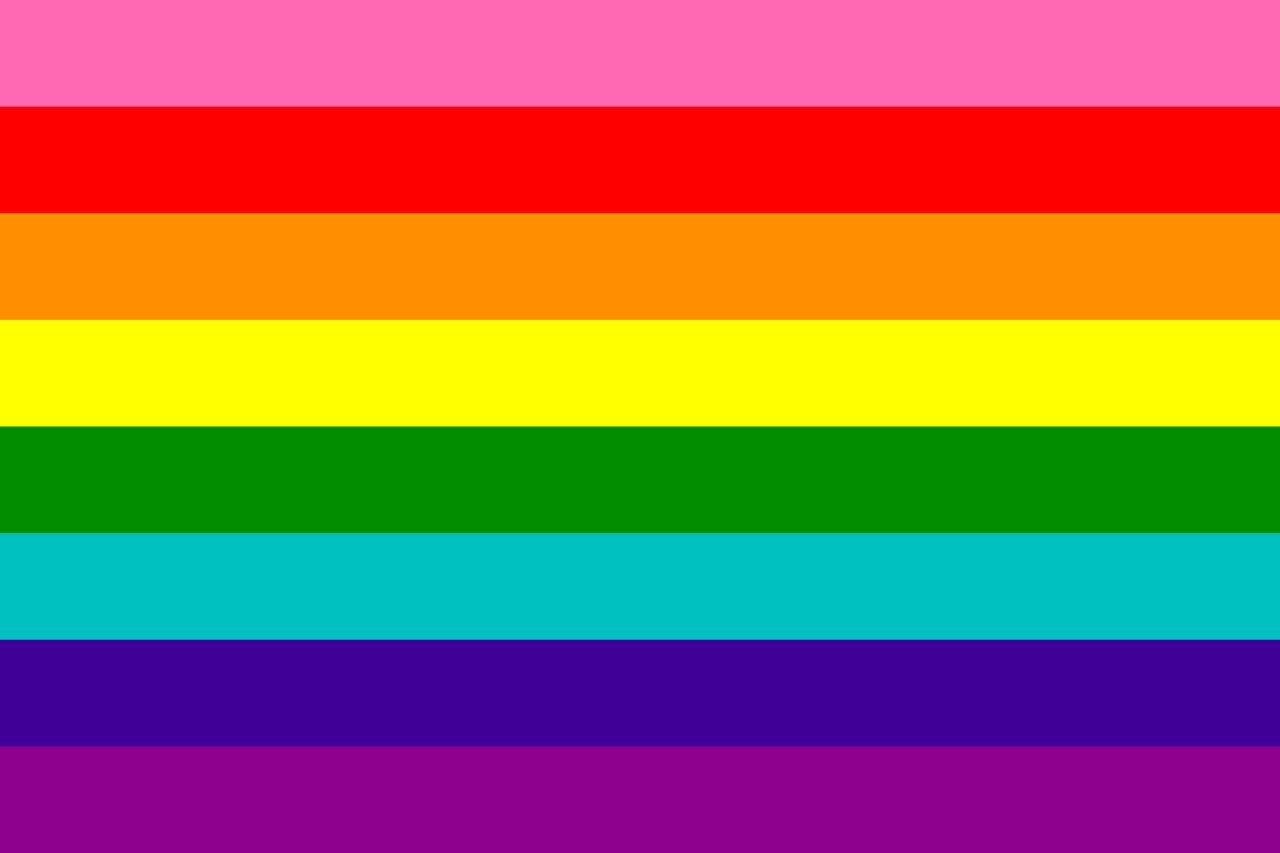 First Gay Pride Flag (1978)
First Gay Pride Flag (1978)
The original flag with eight stripes was replaced the following year due to logistic issues related to the bright pink stripe, which was removed. The second flag contained only seven tripes.
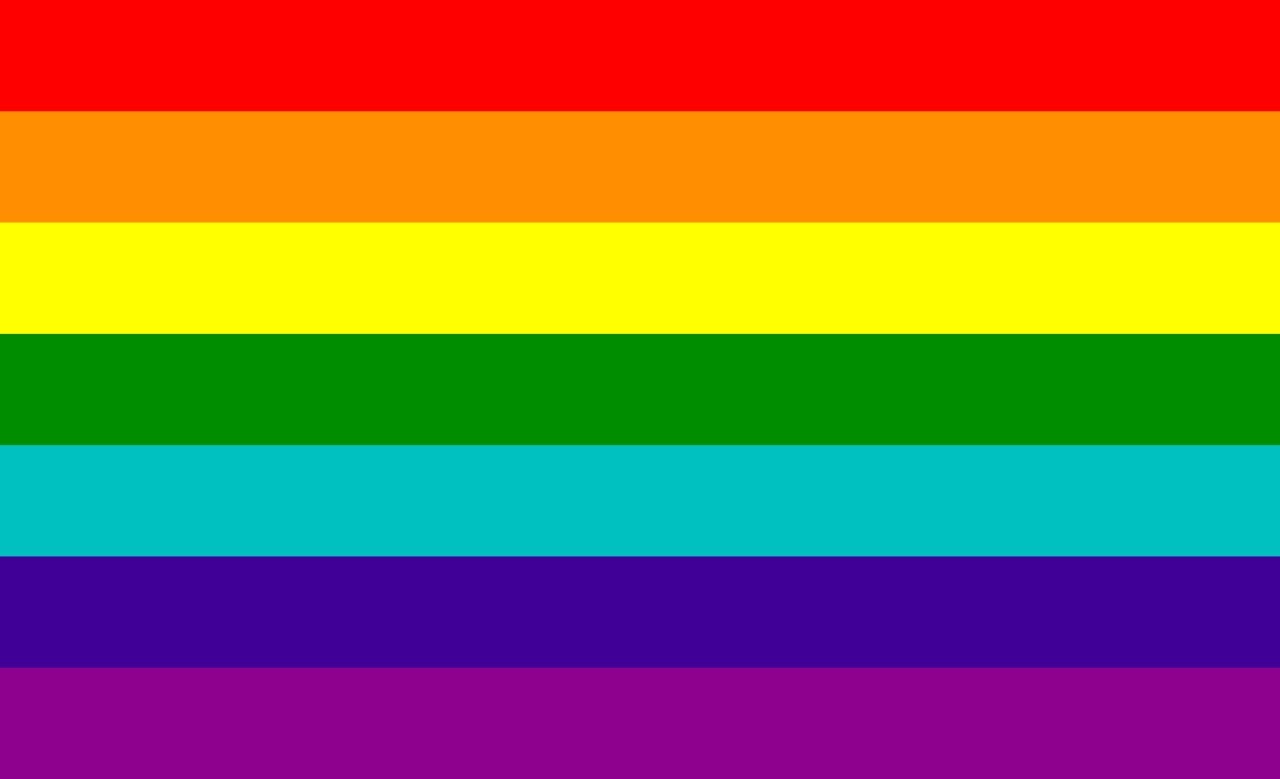 Second Gay Pride Flag (1978-1979)
Second Gay Pride Flag (1978-1979)
The same thing happened with the blue-green stripe, and so this flag was once again replaced by the six-striped design we see around Pride Marches nowadays.
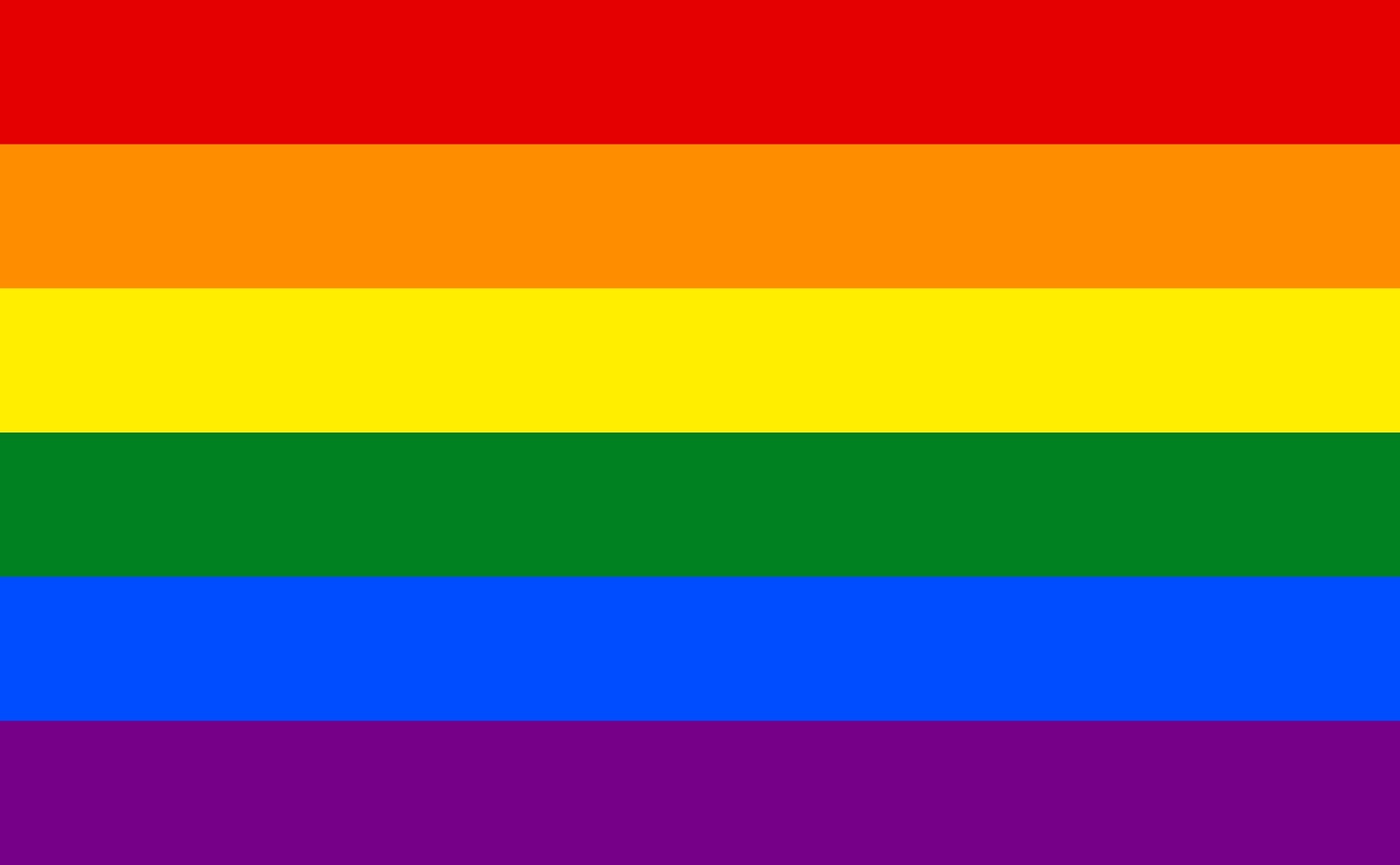 Current Gay Pride Flag
Current Gay Pride Flag
Gay Symbols
In the 1970s, several symbols for the gay community emerged.
The most common identifiers were generated from the male and female gender symbols, which were based on the astronomical symbols for Mars – ♂ – and Venus -♀ . The primary gay symbol is the union of two male gender signs – ⚣ -, and the symbol for gay or lesbian women follows the same logic – ⚢.
 Gay Man Symbol
Gay Man Symbol
 Gay Women/Lesbian Symbol
Gay Women/Lesbian Symbol
The Greek letter lambda (λ) was also used as a symbol for the Gay Activists Alliance and became associated with the Gay Liberation. In 1974, in the International Gay Rights Congress, it was announced the official gay and lesbian rights symbol.
Several other things, from flowers to animals, were also associated with gay symbolism. Some of these are violets, carnations, lavender rhinoceros, unicorns, and the sweet flag plant.
Differences Between Gay and Other Terms
Gay and Queer
While the word gay is used to describe someone’s sexual orientation, queer is more of a broad term, applicable to either gender identity, sexual identity, or both.
Queer is an umbrella term used by people who are not heterosexual and/or not cisgender, which means that queer people can also be gay, and vice-versa.
Gay and Lesbian
The adjective gay can be used by both men and women, but as it started being more associated with homosexual men, the term lesbian emerged to reference gay women.
Even though they are technically synonyms, the word lesbian doesn’t apply to men. The word gay also has slightly broader applicability, since using the lesbian label only makes sense if the person identifies with a woman and is attracted to other women, unlike what happens with the word gay.
Gay and Straight
The distinction between homosexual and heterosexual people was the first sexual identity distinction to be made, and the word heterosexual was actually created to oppose the word homosexual.
In the same way, the word gay opposes the word straight, as the first references same-sex attraction, and the latter references attraction to the opposite sex.
Gay and Bisexual
Both being sexual orientations, bisexual is someone who experiences attraction towards their own gender as well as the opposite gender. Contrarily, being gay is being attracted to one’s own gender exclusively.
Some people may actually fluctuate between using both labels as they discover their sexual identity over time, or they could genuinely experience variations in their sexual orientation through the course of their lives.
Gay and Transgender
A transgender person is someone who does not identify with the gender they were assigned at birth, making it a gender identity.
Being gay, on the other hand, is all about sexual identity, which means that the two words reference completely different things. However, one person can perfectly be transgender and gay if the gender they identify with is the same sex that attracts them sexually.
Gay and Non-binary
A non-binary person is someone whose gender identity falls outside the gender binary of male and female. As it describes one’s relationship with their own gender, it cannot be confused with the same person’s sexual and/or romantic interests.
As the terms used to describe sexual orientations don’t seem to fit non-binary entities, some people still identify as non-binary and gay, sometimes due to the lack of a better designation.
Gay and Pansexual
These words describe two different sexual orientations, yet one could argue that the adjective pansexual absorbs the gay adjective. This means that if one is pansexual, they are also gay, but if one is gay, they are not necessarily pansexual.
Pansexuality is a label someone uses to describe that they are capable of feeling romantic and/or sexual interest towards any person regardless of their gender. This includes same-sex attraction, opposite-sex attraction, and attraction to non-binary entities, and anything in between.
Gay and Drag Queen
Although homophobia served to promote the idea that all drag queens were gay men, drag queens are simply male performers who dress up in a female-like way. Crossdressing or dressing in drag does not define the person’s sexual orientation in any way, nor does it define their gender identity.
As their performance moments do not define their gender identity, they do not define their sexual identity either. One can dress in drag and identify as heterosexual, and another person could also dress in drag and identify as homosexual.
Crossdressing or dressing in drag are not forms of gender expression or examples of same-sex attraction; they are simply a performance for entertainment purposes.
Gay and Asexual
Someone is asexual when they do not experience sexual attraction towards other people. They can still experience romantic attraction, though, and often only towards specific gender identities.
Although asexuality can be considered a sexual identity in itself, it’s not unusual for someone to use the asexual label and still claim a romantic orientation for themselves. For instance, if a person is asexual and gay, it means that they feel romantic interest towards the same sex.
Gay and Aromantic
Aromanticism is the describing word for those who do not experience romantic attraction. Many aromantics are also asexual, but for those who aren’t, they may still use a label to describe the gender that attracts them sexually.
With that said, if someone describes themselves as gay and aromantic, this would mean that they do not feel romantic interest in other people but are capable of being sexually attracted to the same sex.
Gay and Demisexual
For some people, the desire to engage in sexual activity with someone only comes after forming an emotional bond with that person. This is called demisexuality.
When someone uses the gay and demisexual labels to describe their sexual identity, they are saying that they feel romantically attracted to the same sex but will only feel sexually interested once a relationship has been built.
Gay and Polyamorous
Unlike homosexuality, polyamory is a romantic lifestyle and not an orientation in itself.
Polyamory serves as the opposite of monogamy. As so, it’s a way of life in which someone has multiple open relationships with different people at the same time, instead of a single romantic partner.
If the polyamorous individual’s orientation is gay, this means that they are open to having several different open relationships with people of the same gender.
Gay and Polysexual
These two terms are both sexual orientations, but the second is broader than the first. While being gay means being attracted to the same sex, being polysexual means being attracted to multiple genders, although not all.
Although the description could feel redundant, a person can label themselves as polysexual and gay if they experience interest in various different genders, including their own.
How do I know if I’m gay?
Exploring your sexuality should come from within – no one other than yourself can tell you if you’re gay or not. Still, it may not be so simple. Figuring out your orientation can take some time, patience, and introspection.
Maybe you can start by asking if you’ve ever been attracted to someone of the same sex. Attraction can come in many forms, not just sexual. Perhaps just the idea of being with someone of the same sex romantically is a pleasant thought.
In a sexual sense, you can bring up past experiences, if you have any, and reflect on them. If you don’t, maybe you can consider the experience from an abstract perspective and try to understand if it’s something that you would enjoy.
Sometimes, all you need is to reflect on the subject, and with time, answers should be coming to you effortlessly. Of course, it can be challenging or even scary at times, but try to be patient with yourself. Whatever you do, don’t shame yourself for thinking or feeling a certain way.
If you feel like it, go ahead and experiment
When we say experiment, we don’t mean forcefully. There’s a right time and place for everything, and you may want to wait for the right opportunity or person to experiment with. If that means watching out for someone you’d feel comfortable with, that’s okay, too.
Either way, experimenting with same-sex relationships should give you a better idea of whether this is part of your sexuality or not. Just keep in mind that if you have an unpleasant experience with someone of the same sex, that doesn’t mean that all same-sex relations will be bad for you.
Welcome change and fluctuation
Our identity goes through many changes throughout our lives, and these transformations often involve our sexual and amorous interests. You may find yourself less inclined to same-sex relationships at a certain stage of your life, and more inclined later on.
This also means that it’s possible that you may have seen yourself having a certain orientation for a long time, and suddenly you discovered a new impulse, a new desire for same-sex relationships. Maybe a specific person sparked this attraction in you.
However it may be, fluctuations in orientation are perfectly normal and part of our healthy development as human beings. We’re not confused if we find ourselves feeling differently over the course of time, which is the same as saying that being sexually confused isn’t really a bad thing after all.
Embrace curiosity
The term bi-curious is a perfect example of a very common feeling of desiring to explore our sexuality in a way we haven’t contemplated or fully understood yet. It is healthy and freeing to be in touch with the feelings that attract us.
Even if we find that, in the end, it didn’t end up being how we expected it to be, that’s part of the process. As we keep exploring, we keep finding new and more interesting parts of ourselves, which is always wholesome.
In general, the more liberty we give our thoughts and the more spontaneous we let our actions be, the more in sync we become with our identity. As a consequence, we turn into more conscious individuals, with freedom, tranquility, and happiness by our side.
The less we censor ourselves, the better we feel
Don’t let seemingly scary thoughts get in the way of your self-discovery. Your emotions and way of thinking are as valid as they can be, no matter what they are. Prejudice can act as a barrier even in the intimacy of our minds.
If we let it, that is! It’s just a matter of persevering with ourselves and letting spontaneity take the place of fear and apprehension. With time, even the most unusual thoughts can become natural and healthy – it’s just a matter of tolerance and perspective.
Accept yourself either way
It’s okay to feel confused or disoriented. Our identity is a complex topic, and it can be hard to just attribute labels to ourselves. Just remember that no matter the word you use to describe yourself, you are worthy of respect and appreciation.
Gay, bisexual, heterosexual, asexual, pansexual, aromantic – whoever you are, you are you; and that is enough.
Heteronormativity and Homosexuality
Heteronormativity is the belief that heterosexuality is the only natural or acceptable sexuality to have. It is a form of homophobia that implicitly and explicitly foments the discrimination of gay people and the LBTQ+ community in general.
These heteronormative values, promoted by many religions and moral standards, marginalize non-heterosexual behavior on topics from adoption to marriage, creating a truly toxic and debilitating space for gay, lesbian, transgender, and non-binary people.
Conversion and Reparative Therapies
From heteronormativity, conversion and reparative therapies were born in an attempt to correct homosexuality or bisexuality. Their practice proved to be not only ineffective but also profoundly dangerous and conceivably damaging to the subject’s psychological and physical well-being.
As homosexuality began being disconsidered as a mental disorder, such types of treatments were deemed unethical and thus made illegal in many countries around the world.
Homosexuality in Media
Media also plays a huge role in how society perceives the ideal form of love or the acceptable display of affection. As most mainstream shows lack diversity and representation, homosexuality is yet to be normalized in radio, television, cinema, and even advertising.
With shows like Sex Education becoming worldwide sensations, mentalities seem to be changing, even among the most conservative minds. Inclusive marketing is now a thing, and advertising is more aware of diversity than ever.
Paradigm shift
Thankfully, with more accepting laws being approved worldwide, in many places, gay marriage is now legal, adoption by homosexual couples is now possible, and gender transition is now being state-sponsored.
All in all, so many positive changes older LGBTQ+ generations never thought possible have taken place. But we’ve come a long way, and although heteronormativity seems to prevail all around us, slowly but surely, prejudice and discrimination are being defeated.
Religion and Homosexuality
It’s important to make clear that not all religions flagrantly punish homosexuality or condemn it. Despite the discriminatory values promoted by many religions, it’s wrong to assume that each and every religion is homophobic.
Moreover, each religion approaches the subject in different ways. Some even have a positive outlook on homosexuality and are often referred to as gay-affirming religious groups, such as Unitarian Universalism.
Conservative Islam forbids homosexuality and even attributes the death penalty to the homosexual interpretation of Sharia Law. But even within Islam, it is possible to find LGBTQ-affirming Islamic subgroups, for example, Muslims for Progressive Values.
Other religions seem to be divided on the topic, such as Buddhism and Hinduism. However, leaders of these religious groups have come forth about gay rights. It appears that the tendency is for tolerance and acceptance to prevail.
Interestingly, many LGBT themes can be found in mythology and ancient traditions. Mythologies of the Americas, in particular, had intense positive references to homosexuality, for example, the Maya, Aztec, Native American, and Induit cultures.
How can I support the gay community?
Don’t assume everyone is heterosexual
Truly healthy sexual principles aren’t exactly practiced by many people these days, which can make it hard for many to come out of the closet. What’s important to remember is that just because someone isn’t actively vocal about not being heterosexual, that doesn’t mean that they are.
Remember not to ask women if they have a boyfriend or men if they have a girlfriend, or even make any sort of assumptions related to the topic. It can generate a huge sense of discomfort in the other person, even if they don’t clearly manifest it.
Avoid homophobic expressions or jokes
Intent is irrelevant. Words like “sissy” and “faggot” need to leave your day-to-day dictionary. They are microaggressions rooted in your daily vocabulary that make sure prejudice lives a long life, no matter the real purpose behind your affirmations.
Claiming you didn’t mean to offend anyone is no excuse for discriminatory vocabulary. As soon as we take responsibility for that, the sooner we start practicing more inclusive speech.
Be an advocate for gay rights
Even when you’re not among LGBTQ+ people, make a stand. Let others know how you feel about gay people, and not just during Pride month.
Fighting for equal rights doesn’t have to be hard. Simply speak your mind during informal discussions, make an effort to make LGBTQ+ individuals feel welcomed in more conservative environments, and promote inclusive principles with those around you.
Privilege gender-neutral words
Instead of asking someone if they have a boyfriend or a girlfriend, try asking if they have a partner instead. This way, you’re not assuming their sexuality, and you’re simultaneously creating a safe space for them to talk about their love life.
Instead of using pretty for women and handsome for men, simply say attractive. This removes the pressure of fitting into society’s expectations and creates a more wholesome compliment.
Understand that gender expression is different from sexuality
If a woman dresses in a masculine way, that doesn’t make her a lesbian. Her saying she’s a lesbian is what makes her a lesbian. In the same way, being feminine doesn’t make a woman heterosexual. Gender expression does not dictate someone’s sexual interests.
Understanding the difference between gender identity and sexuality will help you learn how to respect everyone’s individuality. Assumptions tend to be toxic and affect the person’s sense of trust or safety.
Words to Live By
Only by speaking out can we create lasting change. And that change begins with coming out.
— DaShanne Stokes
Sometimes it takes more than shouting it to show your pride. It takes more than a sign, a fabulous outfit, or a month of parades. Pride has to resonate from within; shine out to everyone around you. It has mean something to you and only you first before you announce it to the world.
— Solange Nicole
Openness may not completely disarm prejudice, but it’s a good place to start.
—Jason Collins
I’m homosexual. How and why are idle questions. It’s a little like wanting to know why my eyes are green.
— Jean Genet
One day, progress being what it was, I hoped no one would have to have a big gay coming-out or a bisexual coming-out. It would just be what it was, and that would be that. But we weren’t quite there yet.
— S.E. Harmon
The richness, beauty and depths of love can only be fully experienced in a climate of complete openness, honesty and vulnerability.
— Anthony Venn Brown
Pride is not an LGBT celebration, it’s a human rights celebration – it’s a celebration of equality – it’s a celebration of inclusion – it’s a celebration of acceptance.
— Abhijit Naskar
There will not be a magic day when we wake up and it’s now okay to express ourselves publicly. We make that day by doing things publicly until it’s simply the way things are.
— Tammy Baldwin
Things a Gay Person Struggles with Every day
Dealing with expectations of friends and family
Even in the most accepting of environments, misconceptions about homosexuality or deep-rooted prejudices always seem to get in the way.
Learning how to let go of other people’s expectations, especially of those close to us, is what gives us true confidence in ourselves. But it can be a long and difficult process.
Forging meaningful bonds
Finding a healthy relationship is difficult when you’re constantly worried about opening up to the wrong person. Even when it comes to friendships, it can be hard to find someone who respects your sexuality.
Romantically speaking, it becomes a lot more problematic, as many gay individuals still struggle with their identity. Even when you’ve accepted your orientation, being open to dating is a whole other story.
Spontaneity… or the lack of it
Love is a complicated subject, especially so when society seems to conspire against you. It’s hard to feel like you have to hide your emotions or constrain your affections in order to avoid gathering negative attention.
A gay person has the same right to public displays of affection as any heterosexual person does – we’re just waiting for the entire world to become aware of that fact.
Masculine or feminine?
Society seems to tell us we need to choose either one or the other, when in reality, we can be whoever we want to be. Being a more masculine man doesn’t make you less gay, or being a less feminine woman doesn’t make you more gay – it just makes you who you are.
We should be able to express our individuality without any regard to societal gender roles. Most importantly, the way we showcase ourselves to the world, from our dress style to our way of walking, is completely independent of our sexuality.
Prejudice and discrimination
Being looked down on, feeling unwelcome, being made fun of, feeling flagrantly discriminated… those things are more familiar than they should be. And it’s unfair and cruel to have to bear that weight.
It takes a toll on your self-confidence, your mental health, and even on your relationship with those around you. It takes up a lot of courage and determination to keep your head help up high – but that’s just how you show the world you deserve better.
At the end of the day, you’re you, and that’s more than enough.
Even when everything seems to go wrong, and it feels like not a soul in this world understands you, lift yourself up. You’ve got this.
No matter the challenges you face, it’s important to remember your worth. Value your presence in this world – regardless of the adversities, it’s possible to find comfort in being different.
Happiness, love, and success are waiting for you, in every form. Just keep hanging in there.
Inspiring Gay Personalities
Alan Turing
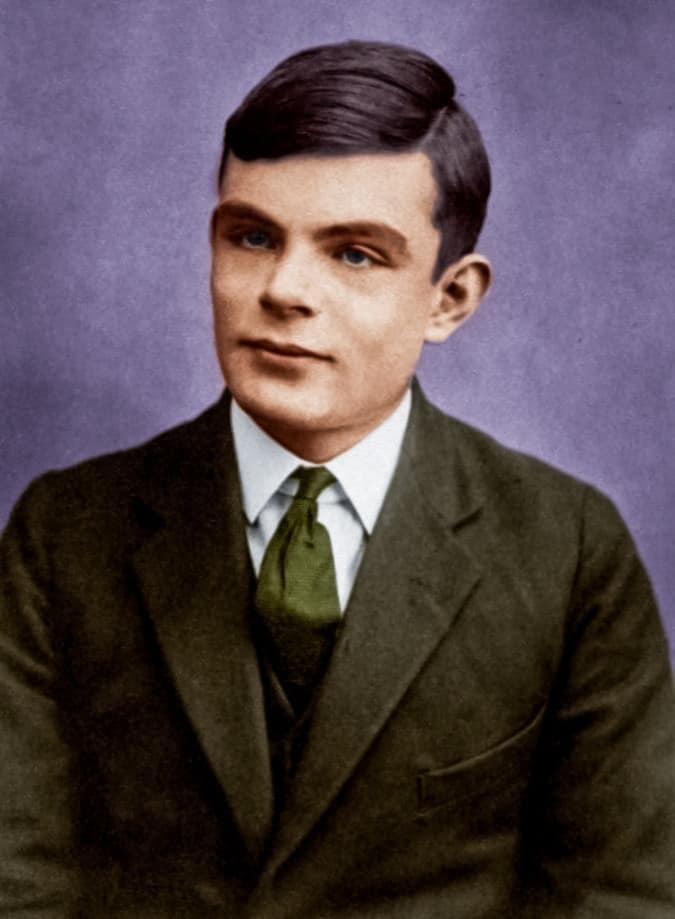 Alan Turing
Alan Turing
The founder of computer science and the cryptographer who helped break the Enigma codes was a victim of state-sponsored homophobia in 1950s England.
After his decisive work in giving the Allies the victory in World War II, Turing was brought to trial and convicted for being homosexual. As a result, he underwent chemical castration and committed suicide shortly after, at the age of 41.
Long after his death, following an Internet plea, the British government officially apologized for the atrocities committed against him. The Alan Turing law is now the unofficial name for the retroactive pardon of the many men who were convicted for being homosexual in the United Kingdom.
Sally Ride
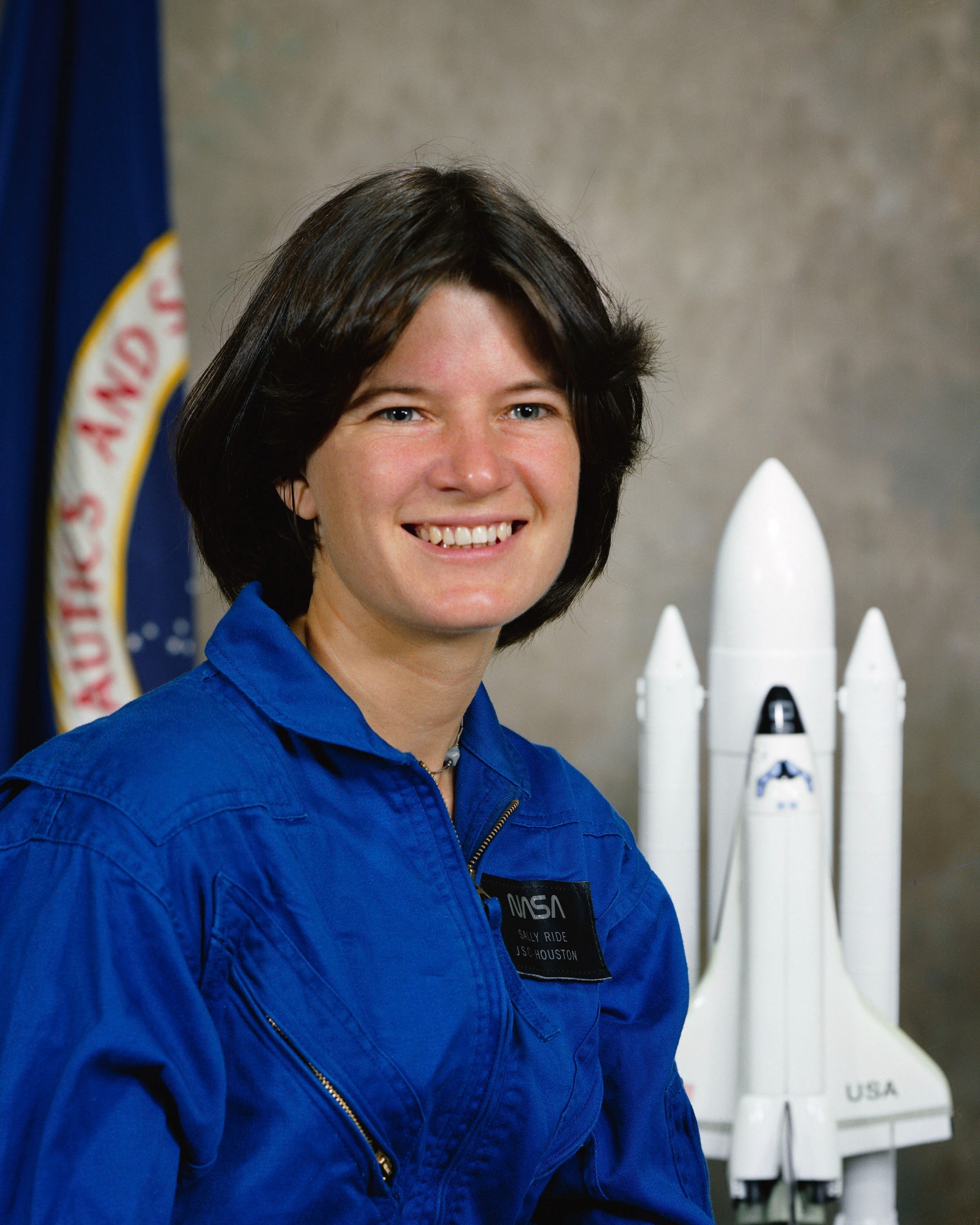 Sally Ride
Sally Ride
Sally Ride was the first North American woman to fly to space. After retiring as an astronaut, she dedicated her life to helping young women pursue science careers, and was awarded a Presidential Medal of Freedom.
Although she was private about her personal life, Ride was openly homosexual and lived and worked with her partner until her death in 2012. She is admired by many for her contribution to women’s involvement in science in the United States.
Harvey Milk
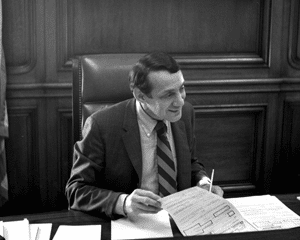 Harvey Milk
Harvey Milk
Harvey Milk was a gay rights activist and one of the first openly gay elected officials in the United States. Fighting the political system from within, his steps are known for making way for a more accepting and tolerant America.
The founder of the San Francisco Gay Democratic Club was murdered by an ex-colleague at age 48, but his legacy lives on. Countless biographies, articles, and even a great motion picture were produced about his life and work.
In 2009, Harvey Milk was awarded the Presidential Medal of Freedom for his outstanding contribution to gay rights in the United States. Several locations in San Francisco were renamed in his honor, including Terminal 1 at the San Francisco International Airport.
James Baldwin
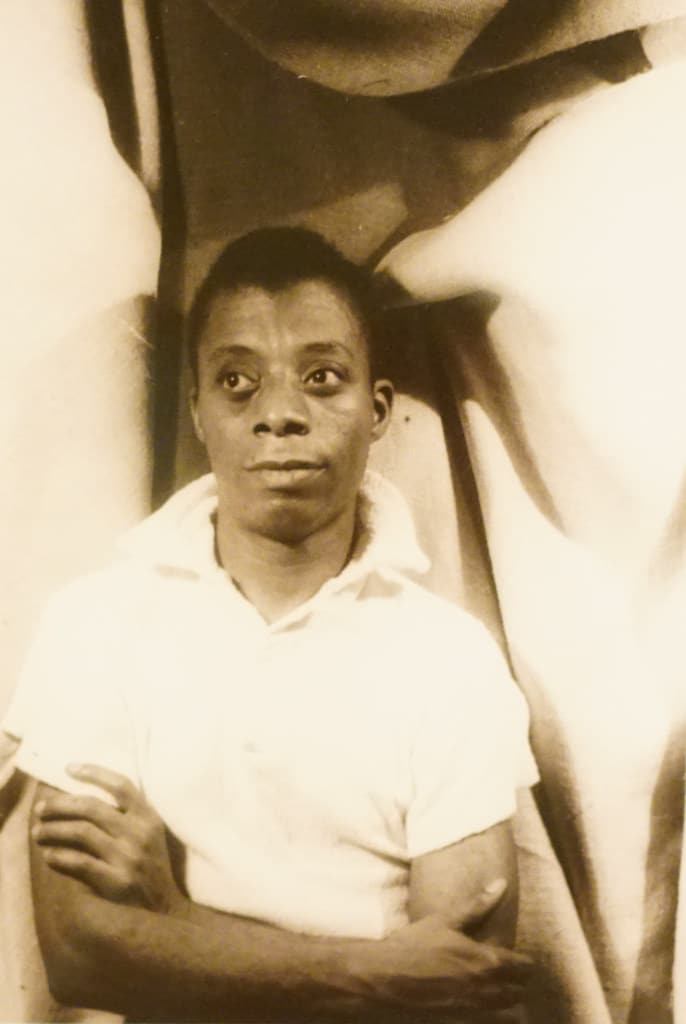 James Baldwin
James Baldwin
Born in 1924, James Baldwin is considered one of the greatest writers of the 20th century. He was openly bisexual and defended that love shouldn’t be limited to labels.
Although his contribution mainly revolved around black civil rights and racial discrimination, homosexuality was also present in some of his novels – Giovanni’s Room (1954) and Just Above my Head (1978).
At the time, a well-known author incorporating such delicate themes in his work wasn’t a usual thing. As he normalized same-sex relationships in literature with his prodigious talent, he contributed to a change of mentality.
Barbara Gittings
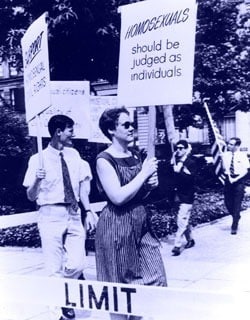 Barbara Gittings
Barbara Gittings
Creator of the first lesbian civil rights organization in the United States, Barbara Gittings began her activist journey in the 1950s and fought for lesbian and gay rights, even at times of strain between the two groups.
Taking on the mission to eradicate homophobia and bigotry from people’s hearts, she is considered by many to be the mother of the LGBT civil rights movement, and her contributions are celebrated with great esteem.
Gittings succumbed to breast cancer at the age of 74, having lived a long life alongside her partner Kay Tobin.
Oscar Wilde
 Oscar Wilde
Oscar Wilde
Born in Ireland in 1854, Oscar Wilde is a world-renowned playwright and poet also famous for being homosexual back when it was a far more sensitive subject.
After making a name for himself with immortal works such as The Picture of Dorian Gray (1891) and The Importance of Being Earnest (1895), he was subject to legal action due to his homosexual relationship with Lord Alfred Douglas.
At times when homophobia ruled western morals and homosexual rights were unheard of, Wilde’s imprisonment was nearly inevitable. After two years in prison, he restationed in Paris, where he passed away from acute meningitis at age 46.
Share this post:
What do you think?
 The rainbow flag
The rainbow flag


